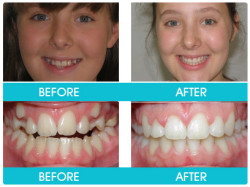Case Study 5
Crowded high upper canines [eye teeth] and open bite
Concern:

This female teenager was referred by her dentist concerned that “… 13 and 23 [upper canines or upper ‘eye’ teeth] are high buccal [on the cheek side] and there is insufficient space for them to erupt into position…”
Examination showed only her back teeth [first molars] bit together; all other teeth were apart and could not bite together [open bite]. Her upper eye teeth were jutting out of her upper jaw high in her gum line. Her lower teeth were straight.
Radiographic analysis confirmed the diagnosis of open bite [black air space between the white teeth on the embedded radiograph]. Only 4 of 24 erupted adult teeth were able to bite together. The open bite was therefore classified as a ‘skeletal open bite’ [due to the growth pattern of the jaws] and not a ‘dental open bite’ [due to under-eruption of the teeth]. All second molars were present and unerupted. All wisdom teeth [3rd molars] were missing.
Treatment Performed:
 Two options for treatment were proposed:
Two options for treatment were proposed:
- Braces with removal of all first permanent molars to bring the teeth together and close the open bite [‘dental camouflage’ of the skeletal open bite]. Estimated treatment time 24 months
- Try and treat without removal of adult teeth. Braces with temporary anchorage devices [TADs] or miniscrew implants inserted in the jaws. Pressure to the upper first molars to lift them out of contact with the lower first molars to allow the other teeth to bite together. Estimated treatment time about 24 months.
It was decided to proceed with treatment as outlined in option 1. The patient was referred for removal of her first molars under sedation before commencement of treatment.
Treatment was undertaken with braces to her upper and lower teeth. Elastic bands were worn for a period of 4 months. Total treatment time was 23 months.
Result:
‘Skeletal’ open bites remain challenging even to this day to ‘close’ [bring the teeth together].
In the past and even today jaw surgery combined with orthodontic treatment is a common modality used to ‘close’ the ‘skeletal’ open bite and bring the teeth together. This relies on the skills of the surgeon [surgical repositioning of the jaw/s] and the orthodontist [placing the teeth in the correct position in the jaw], working as a team, to achieve a successful outcome. Teeth typically need to be removed with this approach, even if they are only wisdom teeth. Some open bites require a combined surgical and orthodontic approach for closure.
Advances in orthodontics and biomechanics are seeing miniature titanium screw implants [TADs or miniscrew implants] being incorporated into orthodontic treatment to enable closure of some open bites without the need for jaw surgery. These miniscrew implants are ‘retrievable’ implants that are placed [and removed when no longer required] in the jaw bone/s during orthodontic treatment. They act as fixed anchor points for closure of the open bite via the application of pressure to the teeth which are contacting. The pressure separates the teeth which are contacting. This allows the teeth which are apart to come together. When there is even contact of all the teeth the pressure from the TADs to the teeth is removed. Teeth may/may not need to be removed with this treatment modality.
In select cases, removal of teeth combined with traditional orthodontic treatment without either miniscrew implants or jaw surgery can be the method of choice used to treat [close] the open bite. This case represents an example in which teeth were removed for open bite closure and also relief of crowding. The improvement in the alignment of the upper teeth and the bite [function] is readily appreciable in the photographs below.

